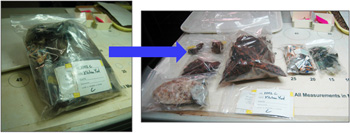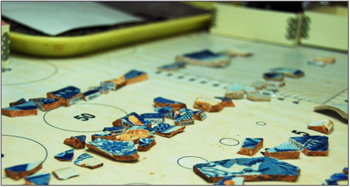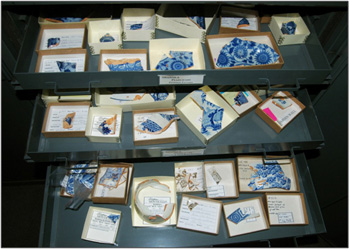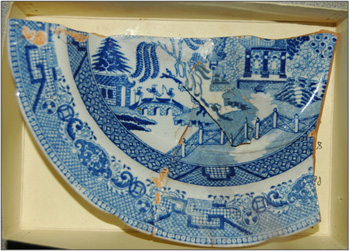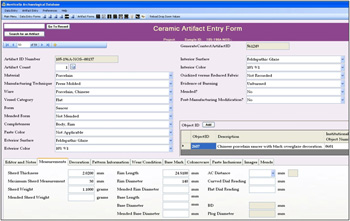A Typical Day in Archaeology
"So you work in the Archaeology Lab...but what do you do, exactly?" This is a question I have received a lot over the years from friends and visitors alike. The answer is, quite a variety of things, actually. Archaeology entails a lot more than the digging part. That’s what I love about it; it’s a little different every day.
My current project is the Mulberry Row Reassessment (MRR), scheduled to end this spring. This project focuses on re-analyzing field records and re-cataloguing artifacts found by Dr. William Kelso in the 1980s excavation of Mulberry Row. Information from the thousands of field records and over a million artifacts are entered into our database, part of the Digital Archaeological Archive of Comparative Slavery (DAACS).
The MRR project entails a lot of different kinds of work. For instance, one day might be spent digging through documents at the library, trying to figure out what Jefferson wrote about, say, constructing the Joinery on Mulberry Row. The next day might be spent trying to figure out a site’s stratigraphy; that is, how and when layers of soil and artifacts were deposited relative to each other. Finally, I might round out the week by processing and cataloguing artifacts, a process that takes up the majority of our time in the lab.
Speaking of cataloguing, that happens to be what I’m working on today. My colleagues and I are working on artifacts from this box, which contains artifacts from different contexts, or distinct deposits, in the East Kitchen Yard area. The East Kitchen Yard is the last site to be catalogued as part of the MRR.
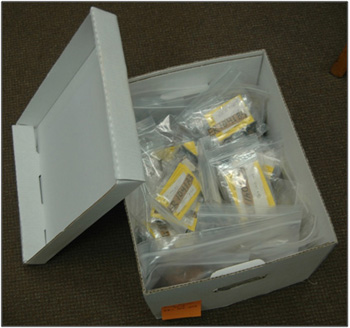
Each bag of artifacts is filled with smaller bags containing artifacts separated by material type. For example, this bag has stone, brick, wood, metal, glass, and ceramic artifacts that were all found in an excavation square in the East Kitchen Yard. It also contains basic excavation information that gives the context within which the artifacts were found, in this case excavation unit 1042, level C (hence 1042C).
Once I see what needs to be catalogued in this artifact bag, I decide to dive into the ceramics. I start by sorting the sherds by ware type, with stonewares on the left, earthenwares in the center, and so forth. I can tell the difference between ware types based on a number of factors, including what the sherd’s paste (ceramic clay), glaze, and decoration look like. I also group decorated ceramics together and make vertical groupings by what part of the vessel is present. Call me Type A, but it makes entering info into the computer a lot faster to do like things together. The different ceramics seen here represent close to a hundred years of occupation on Monticello Mountain.
Here is the decorated earthenware group, specifically a group of early 19th-century transfer-printed pearlwares imported from England, anxiously awaiting cataloguing. The ceramics are laid out on my cataloguing mat, which has a series of measured circles used while cataloguing.
Here is a close up view of a few porcelain sherds with intricate decorations. The photo on the top has two sherds that are likely from the same vessel, but unfortunately don’t quiiiite fit together. These 3 sherds were originally manufactured in, and imported from, China.
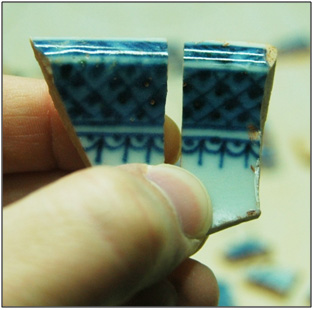
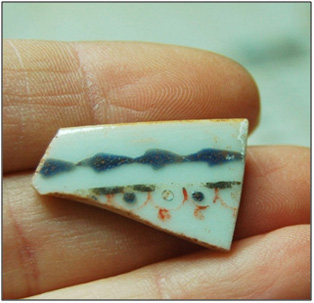
Sometimes we’ll run across a ware type or decoration that we are not familiar with. When this happens, we make use of our large study collection. Housed in almost 20 large cabinets, this collection serves as a reference collection for comparing a small sherd to a larger vessel.
For example, I think one of my sherds in this bag is part of a plate with the Willow Pattern printed on it. So I take it over to the study collection, do a quick comparison and – voilà! – it’s the Willow Pattern.
Now that I know what everything is, I’m ready to enter information into our database. We record as much information as possible for each artifact. For ceramics, that includes ware type, form (what type of vessel it is), decoration colors and techniques, decoration patterns, glaze types, manufacturing methods, measurements, etc. The idea is to create as complete of a digital record of each artifact as possible.
Each artifact is recorded in this way, although some artifacts can be grouped together when catalogued. My rows of ceramics might not look like much, but by my estimate, this bag of ceramics will require filling out about 115 individual entry forms. It is now the afternoon and this single bag of ceramics will keep me busy for the rest of the day and probably into tomorrow. And then, who knows what will be found in my next bag of artifacts?
